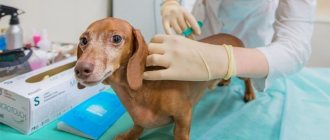A new addition to a cat family is a good event, because it is a joy not only for the cat itself, but also for its owners. Little fluffy balls, with their helplessness, make people want to protect them as if they were their own children. At first, the only reference point for babies is their mother, but when the kittens’ eyes open, a new stage in learning about the wonderful world begins. And although the mother cat must take care of the kittens, the owner is obliged to monitor the growth of the babies, periodically weighing them and observing when their eyes begin to open, ears rise, and teeth erupt.
At what age does this happen?
The most important event for a cat's baby is the opening of its eyes. The process begins at approximately 2 weeks of life and lasts about 7 days. At first, babies slightly open their slits - their eyes, which become wider every day.
For the first 7 days, newborns do not see or hear anything around. At the beginning of life, it is necessary for them to be in a dark room; bright light negatively affects the development of the visual organs. After opening, the eyes are cloudy, with motionless pupils, until they begin to respond to stimuli and transmit signals from the optic nerves to the brain. After 2-3 days, the pupil becomes mobile, and the membrane of the eyes becomes transparent. After the eyelids open, kittens begin to move more and pay attention to objects that are interesting to them.
Kittens in the first week of life
Newborn kitties in the first week of their life are absolutely helpless: they cannot see (at birth their eyes are closed), hear (because the ear canals are blocked) and cannot even walk. They crawl slowly and chaotically in search of their mother's nipple. For the first 20 days of life, kittens need exclusively maternal care and warmth, since their body temperature is much lower than that of adults and thermoregulation is still poorly developed.
With the birth of offspring, cat owners often build a place where the new mother spends all her time with the babies, so that they do not crawl away or no one accidentally steps on them. This could be a large cardboard box with bedding. The only thing the owner can do to help the cat during this period is to keep the box clean, because if the cat finds the bed dirty, it will take its children to a more favorable place.
Why are kittens born blind?
Cubs are born blind, which is provided by nature to preserve their eyes. In addition, there are several reasons for this phenomenon:
- The babies' eyes are closed to protect them from infections, which often enter the mother cat's body and can be transmitted to offspring.
- The animal's amniotic fluid, in which the kitten swims, is also far from clean. Since immunity in fetal development has not yet been formed, this helps to avoid diseases of the organs of vision.
- Since a cat’s pregnancy proceeds very quickly, the development of the visual organs does not have time to fully occur in the mother’s body and continues after birth.
Features of newborn kittens
Tiny animals are born deaf, blind, with barely noticeable signs of life. This is completely normal and don’t be alarmed if the “lump” doesn’t react to you in any way.
Development will occur gradually, and humans should not interfere with this natural process.
A cat, even if this is her first birth, is endowed with all the instincts to raise her offspring. The babies will begin to hear and open their eyes soon enough, you need to be patient and wait.
© shutterstock
What determines the timing of eye opening in kittens?
The time it takes for babies to open their eyes is influenced by many factors.
Breed
It is genetically determined that in kittens of different breeds, the opening of the eyes takes a different period of time:
- Newborn Ragdolls are characterized by extremely slow development of their visual organs - pets begin to see in the 3rd week of life and later.
- Maine Coons begin to see sight 14-16 days after birth.
- Cubs of Siberian breed pets open their eyes at 12-17 days, just like British ones.
- Small Cornish Rex can see at 5-7 days.
- Kittens of Siamese, Abyssinian and Sphynx breeds are sometimes born with open eyelids and vision becomes focused by 3-4 days.
- Scottish Fold, British and Bengal newborns begin to see 7-9 days after birth.
- Kittens of short-haired breeds develop faster than long-haired ones.
Floor
In female kittens, the process of opening their eyes is faster than in males. In addition, the stronger and more active the kitten, the sooner they will open. It is useful to hold babies in your hands or stroke them. The cat begins to lick the offspring more intensely and more often to get rid of foreign odors, thereby accelerating the development process of the kittens.
Date of birth
The period of gestation of babies affects the speed of their development after birth.
The longer a cat carries offspring, the faster the newborns open their eyelids, the higher the likelihood of them being born with open ones. In this case, it is necessary to pay special attention to moisturizing the membranes of the eye, otherwise the development of diseases is likely.
Health status
Healthy babies who have enough nutrients and are well-groomed open their eyes much earlier than those whose condition is worse. Viruses and the presence of congenital pathologies slow down the development process.
When do kittens start to hear?
Hearing, like vision, is an integral part of a cat, because thanks to its acute and sensitive hearing it can hunt. Newborn kittens are blind and deaf due to their still poorly developed nervous system, so they are completely and completely dependent on their mother. Kittens learn to hear earlier than when they begin to open their eyes. This mainly happens on days 5-8, as the ear canal gradually begins to open. At first the baby's ears are flattened, but then they will rise.
Important! During the period of hearing formation, it is necessary to provide the kitten with peace and quiet.
As with vision, the rate at which a kitten develops depends on what breed it belongs to. Often, kittens of short-haired breeds begin to see and hear faster than their fluffier counterparts.
At first, kittens only sleep, sometimes waking up to eat. For this reason, lack of vision does not affect their life activities. After some time, when the kittens open their eyes, they become mobile and active. If the owner takes part in caring for the babies, all his efforts will pay off with the invaluable trust of the cat.
When does eye color appear?
For several days after opening, the kitten’s vision organs have a cloudy bluish tint. The baby does not see, but distinguishes between light and darkness. After a week, the delicate pupil begins to adapt, and it becomes easier for the kitten to tolerate bright light. At this age, everyone's eyes are the same color. Individual pigmentation begins to form at 4 weeks of life and becomes noticeably visible after 3 months.
Full vision appears at the age of about a month.
At approximately 3 months, it begins to change based on the breed and color of the animal. For each breed, this period is individual and can fluctuate up or down. The final color of the eyes is formed by six months of the animal’s life. In Siamese kittens it is brightest during adolescence and fades as they grow older.
How to care for a kitten before it opens its eyes
Until the period when the kitten begins to see, it is necessary to keep it in twilight. The place should be secluded, protected from the sun, preferably sharp flashes of light.
Usually the mother cat does a good job of keeping the family nest clean. You shouldn’t worry about the kittens’ excrement at this time; the mother will take care of it. But it is important to monitor the condition of your eyes. It is recommended to wipe the eyelids and eyes of kittens 1-2 times a day with a strong infusion of tea or another alcohol-free antiseptic (potassium permanganate solution, furatsilin). This will prevent harmful bacteria from entering the mucous membrane and causing suppuration.
This care should be continued even when the kitten’s eyes are already opening. As with children, furry babies may have secretions that accumulate in their eyes and should be removed by wiping their eyelids. Careful care is recommended for the first month of the offspring's life.
What to do if your eyes do not open on time
If a cub does not open its eyes for more than 2 weeks, this is not a cause for alarm. It is necessary to carefully examine the animal's eyelids. If there are no signs of inflammation, you can wash your eyes with a weak solution of boric acid or strong tea. You can take a moistened cotton pad and wipe your eyelids.
If they stick together, sour and crusts form, you must first soak them and then wipe them with light movements, avoiding pressure. If decay or inflammation is noticeable, you should immediately contact your veterinarian so that he can prescribe special drops.
1111
How do kids see?
Even if by 10-14 days the kittens open their eyes completely, their vision is still poor. They begin to see clearly only after 2 months. And all this time they understand what is happening only by relying on the smell, the feeling of warmth from their mother and littermates.
At 3 weeks, vision begins to improve. At 1 month, the kitten sees objects almost clearly in order to avoid bumping into them. But the baby is still clumsy, as eye-paw coordination has not been established. At the age of 1.5 months, he sees well enough to find food or bypass some object in his path.
Cats are good mothers. They take full care of the offspring and ensure their cleanliness. The owner’s task is not to disturb the cat, but also to regularly examine the babies in order to take timely measures.
Expert advice
Veterinarians and experienced felinologists advise animal lovers who decide to get a kitten to do the following:
- Once pregnancy is established, the cat is switched to premium dry food or higher and is provided with sufficient food.
- At 2 weeks the baby's incisors erupt, and from three weeks the animal can chew granulated food. From this moment on, kittens are given dry food. By the age of two months, the cat's mouth will be armed with twenty-six teeth.
- For the safety of the babies, they are given a special playpen for kittens.
- The area around the cat's den is covered with carpet.
- Before the babies get stronger and begin to leave the nest, dangerous objects are removed.
Be sure to read:
How to calm a cat when he wants a cat: methods, valerian drops, folk remedies
If the kitten is injured, call a veterinarian. You cannot hesitate, otherwise the cub will die or become disabled. Transport to a hospital may worsen the injury. The cat is kept motionless until the doctor appears.
Features of the development of cat vision
Kittens' eyes begin to open gradually, this process takes from 1 to 3 days. First, the inner corner opens slightly, and then the slit begins to increase, and the iris of the eye opens slightly.
Babies begin to distinguish objects at the age of 5 - 10 days. On average, kittens' eyes fully open no earlier than 2 weeks after their birth.
Until this time, it is recommended to keep small pets in a dark place, protected from exposure to direct ultraviolet rays, which can damage their delicate pupils.
Causes for concern
The development of each kitten is a purely individual process, however, if even after the twentieth day of life it has not opened its eyes, and purulent discharge is clearly visible on the outside, it means that certain measures will have to be taken.
If the eyes become sour with the formation of a crust on them, which prevents the baby from opening his eyelids, you should help him a little.
At a minimum, you need to organize a darkened place protected from drafts, since the inflammatory process that appears can be caused precisely by external unfavorable factors.
In addition, it will be useful to regularly wipe your eyelids with a cotton swab slightly moistened with weak tea leaves.
Important! Under no circumstances should you forcibly tear apart a kitten’s eyes. This way you can damage them, and the baby will have vision problems in the future.
The tea leaves used must be black and of good quality, and all movements are performed extremely gently and without sharp pressure.
Usually the result of such rubbing is noticeable almost immediately: slits appear, which enlarge the next day, and the eyes open completely. Further development of the visual organs occurs according to the usual scenario and does not differ in any particularities.
As an alternative to tea leaves, you can use a solution of medicinal boric acid and water in a ratio of 1:10. This product also soaks the crusts well, but the main thing here is not to make a mistake so as not to burn the baby’s face.
Did you know? Small cats' eyes begin to open earlier than their brothers' eyes, although after a few weeks you won't notice the difference between them.
If none of the above has brought the desired result, then it is better to contact a veterinarian and together with him determine further actions.
Of course, in some cases, kittens are actually born blind and even with their eyes fully open, the pupils do not react to bright light. Unfortunately, most often, vision will never be restored, but despite this, such special animals adapt well to life in the environment.
Possible problems and methods for eliminating them
It is possible to worry and do anything about the kitten’s eyes not opening only after 21 days of age. Until this moment there is no particular reason to panic. But to be on the safe side, after the second week of development, the babies’ eyes are periodically examined. A simple rule will allow you to notice possible deviations in time.
Problem #1: Eyelid Fusion
If the eyelids are partially fused, you can try a gentle massage.
Initially, carnivores are born with eyelids fused, but by two to three weeks of age they should open. If by this time the gap has not appeared, the eye sockets look swollen, pus accumulates in the corners of the eyes and on the eyelids themselves, then it’s time to sound the alarm.
With partial fusion, a gentle massage with gradually increasing stretching will help. The peels are pre-soaked with drinking tea. After the procedure, the edges of the eyelids are lubricated with boric alcohol.
If the upper and lower eyelids are completely fused and firmly attached, surgery will have to be performed by an experienced veterinarian. The work is not difficult, but requires care and caution.
- To begin with, novocaine is instilled into the conjunctival sac for pain relief.
- After a few minutes, the fusion line is cut with a sterile and sharp scalpel.
- After which, for another two or three days, the edges of the eyelids are lubricated with boric petroleum jelly and the eyes are washed with saline solution to prevent re-sticking.
Problem #2: conjunctivitis
The eyes may not open as a result of conjunctivitis, which develops against the background of an infectious process or some kind of injury, for example, accidental scratching by one of the brothers or sisters. The disease is accompanied by swelling of the eyelids, their sticking together due to dried discharge of a dirty brown color.
What can be done?
- The eyes are washed daily several times a day with a weak solution of tea or ordinary boiled water. This will help to first soften and then completely wash away the pus that prevents the eyelids from opening.
- Instead of sleeping tea leaves, you can use special preparations. Ask your veterinarian which drops to take.
- Usually, after a couple of days of simple therapy, the eyes return to normal and the kitten feels great.
- If the process is prolonged and pus continues to be released, then the discharge is sent to the laboratory to identify the causative agent of the pathology.
- The specialist chooses further treatment based on the analysis results.











